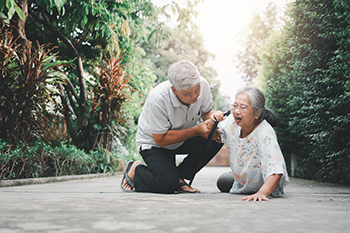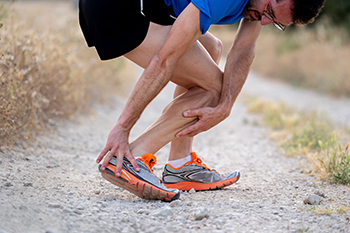Freehold (732) 294-9393
Freehold (732) 294-9393

There are various forms of running and most require a specific type of running shoe to be worn. Running can range from training for a marathon to a new hobby. Studies suggest that it is beneficial to begin the process of purchasing running shoes by examining the wear patterns on existing shoes. A person who pronates normally will often notice wear and tear on the sole where the ball of the foot is. If there is excessive wear on the inside of the sole, the runner may have overpronation. Conversely, wear on the outside of the sole can indicate underpronation, and knowing these patterns can make it easier to choose running shoes that fit correctly. Additionally, it is beneficial to decide what surface you will be running on, such as trail, road, or treadmill running. Buying running shoes can be overwhelming, so it is suggested that you confer with a podiatrist who can provide additional information as well as their recommendation for you.
You should always make sure your running shoes fit properly in order to avoid injury. For more information, contact Dr. Henry Miller from New Jersey. Our doctor can provide the care you need to keep you pain-free and on your feet.
Choosing the Right Running Shoe for Your Foot Type
Improper shoe sizing can cause a myriad of problems for your feet. Shoes that don’t fit you properly can lead to muscular imbalances in your body, which can result in foot, knee, and hip injuries.
Tips for Finding the Right Running Shoe
If you have any questions please feel free to contact our our office located in Freehold, NJ . We offer the newest diagnostic and treatment technologies for all your foot and ankle needs.

Corns can cause patients to have severe pain, despite their small size. They can develop as a result of excess friction, which generally happens from wearing shoes that do not fit correctly. A common area where a corn can be found in the side of the pinky toe. The pain can be so severe, that larger shoes may need to be purchased to lessen its severity. Corns that form between the toes are called soft corns, as they are consistently moist from the sweat that is found there. Some patients have corns that form on top of the toes, and this may be from an existing bunion or hammertoe. Patients who have small corns may find mild relief when the foot is soaked in warm water, followed by using a pumice stone that can wear the dead skin away. For more severe corns, it is suggested that a podiatrist be contacted, who can prescribe medicine that may shrink it, or possibly trim it surgically.
Corns can make walking very painful and should be treated immediately. If you have questions regarding your feet and ankles, contact Dr. Henry Miller of New Jersey. Our doctor will treat your foot and ankle needs.
Corns: What Are They? And How Do You Get Rid of Them?
Corns are thickened areas on the skin that can become painful. They are caused by excessive pressure and friction on the skin. Corns press into the deeper layers of the skin and are usually round in shape.
Ways to Prevent Corns
There are many ways to get rid of painful corns such as:
Treating Corns
Although most corns slowly disappear when the friction or pressure stops, this isn’t always the case. Consult with your podiatrist to determine the best treatment option for your case of corns.
If you have any questions please feel free to contact our office located in Freehold, NJ . We offer the newest diagnostic and treatment technologies for all your foot and ankle needs.

One of the main reasons seniors fall is because of a loss of balance. This can be caused by dizziness, muscle weakness, or side effects of certain medications. One fall prevention technique is embarking on an exercise program specifically designed to increase balance and stability. Before taking on any new exercise regime, it is a good idea to check with a medical professional. Among the ways to improve balance are gait training, which is designed to improve the way you walk, and resistance training in a pool to help strengthen the leg and foot muscles. Walking backward and heel-to-toe walking are other methods of improving balance. Standing on one foot for a few seconds, then switching feet is another technique. Caution should be taken when performing these exercises to be near a wall that you can touch if needed. Also, it is wise to have a friend or caregiver present. Further, it may be necessary to invest in an assistive device, such as a cane or walker, to help you complete your daily activities. For more information on preventing falls, please consult a podiatrist.
Preventing falls among the elderly is very important. If you are older and have fallen or fear that you are prone to falling, consult with Dr. Henry Miller from New Jersey. Our doctor will assess your condition and provide you with quality advice and care.
Every 11 seconds, an elderly American is being treated in an emergency room for a fall related injury. Falls are the leading cause of head and hip injuries for those 65 and older. Due to decreases in strength, balance, senses, and lack of awareness, elderly persons are very susceptible to falling. Thankfully, there are a number of things older persons can do to prevent falls.
How to Prevent Falls
Some effective methods that older persons can do to prevent falls include:
Falling can be a traumatic and embarrassing experience for elderly persons; this can make them less willing to leave the house, and less willing to talk to someone about their fears of falling. Doing such things, however, will increase the likelihood of tripping or losing one’s balance. Knowing the causes of falling and how to prevent them is the best way to mitigate the risk of serious injury.
If you have any questions, please feel free to contact our office located in Freehold, NJ . We offer the newest diagnostic and treatment technologies for all your foot care needs.

Many people have taken to running as a way of improving their overall health, but with this form of exercise comes an ever-present risk of injury to the ankles and feet. The four main categories of running injuries are overuse, trauma, fractures, and sprains and strains. The risk of these types of injuries is enhanced by being overweight, increased distance, and running in worn-out shoes. One of the top overuse injuries incurred by runners is plantar fasciitis, which causes heel and arch pain. A second overuse injury that is common to runners is Achilles tendinopathy. The pain runs down the back of the leg to the heel, causing stiffness and swelling. Another common running injury is ankle sprains, the result of twisting or turning your foot beyond its natural limits. This stretches or tears the ligaments that hold the ankle in place, resulting in pain and swelling. The first and best way to avoid running injuries is to invest in properly fitted shoes that offer the support and cushioning needed. For information about preventing running injuries, please consult a podiatrist.
Exercising your feet regularly with the proper foot wear is a great way to prevent injuries. If you have any concerns about your feet, contact Dr. Henry Miller of New Jersey. Our doctor will treat your foot and ankle needs.
How to Prevent Running Injuries
Many common running injuries are caused by overuse and overtraining. When the back of the kneecap starts wearing out and starts causing pain in your knee, this is commonly referred to as runner’s knee. Runner’s knee is a decrease in strength in your quadriceps and can occur if you’re not wearing properly fitted or supporting shoes. To prevent runner’s knee, focusing on hip strengthening is a good idea, as well as strengthening your quads to keep the kneecaps aligned.
What Are Some Causes of Running Injuries?
- One cause of a common running injury is called iliotibial band syndrome.
- Plantar fasciitis is also another common injury.
- Stress fractures can occur from overtraining, lack of calcium, or even your running style.
Best Ways to Prevent Running Injuries
- Wear footwear that fits properly and suits your running needs.
- Running shoes are the only protective gear that runners have to safeguard them from injury.
- Make a training schedule. Adding strengthening exercises as well as regular stretching can help keep you strong and limber and can lessen the possibility of injuries.
- Stretching keeps muscles limber; this will help you gain better flexibility.
If you have any questions please feel free to contact our office located in Freehold, NJ . We offer the newest diagnostic and treatment technologies for all your foot and ankle needs.

All of the toes, except for the big toe, have three bony segments that are separated by joints. The foot condition that is known as hammertoe can cause the joints that are between the first and second segment to bend downward, and it generally affects the second and third toe. It is considered to be a deformity, and can be caused by genetic factors or from wearing shoes that do not fit correctly. These types of shoes typically do not have adequate room for the toes to move freely in and can change the shape of the foot. Many patients can experience pain in the ball of the foot, and difficulty in finding shoes that fit properly. Additionally, corns may develop on top of the toes as a result of friction that is caused by the toes constantly touching the top of the shoe. Hammertoe is easy to diagnose, and X-rays are often not necessary to take. Relief may come from performing specific stretches, and cushioned pads may be used on top of the corns. If you have developed hammertoe, please speak to a podiatrist who can diagnose and offer you correct treatment solutions, which may include surgery for permanent straightening.
Hammertoe
Hammertoes can be a painful condition to live with. For more information, contact Dr. Henry Miller from New Jersey. Our doctor will answer any of your foot- and ankle-related questions.
Hammertoe is a foot deformity that affects the joints of the second, third, fourth, or fifth toes of your feet. It is a painful foot condition in which these toes curl and arch up, which can often lead to pain when wearing footwear.
Symptoms
Causes
Genetics – People who are genetically predisposed to hammertoe are often more susceptible
Arthritis – Because arthritis affects the joints in your toes, further deformities stemming from arthritis can occur
Trauma – Direct trauma to the toes could potentially lead to hammertoe
Ill-fitting shoes – Undue pressure on the front of the toes from ill-fitting shoes can potentially lead to the development of hammertoe
Treatment
Orthotics – Custom made inserts can be used to help relieve pressure placed on the toes and therefore relieve some of the pain associated with it
Medications – Oral medications such as anti-inflammatories or NSAIDs could be used to treat the pain and inflammation hammertoes causes. Injections of corticosteroids are also sometimes used
Surgery – In more severe cases where the hammertoes have become more rigid, foot surgery is a potential option
If you have any questions please contact our office located in Freehold, NJ . We offer the newest diagnostic and treatment technologies for all your foot and ankle needs.